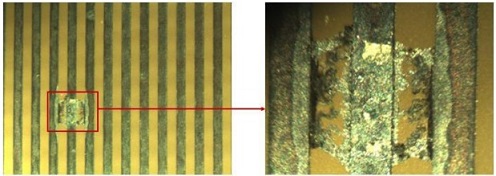Defect Description
Intermittent failures on components can be exhibited by improper function, intermittent loss of signal integrity, data error, etc [1].
Unlike other latent defects that yet to have caused any failures, intermittents are already-happened-failures that needs to be detected rather than precipitated.
Defect Formation Process(s)
Many causes can lead to intermittent failures in semiconductor devices. 4 common examples are included below:
Creep corrosion between isolated leads can lead to intermittent loss of signal integrity depending on the insulation resistance of corrosion products based on their nature (conductive, semi-conductive, dry or wet) [1].
Tin whisker formation due to stresses in the tin plating, for example, residual stresses in the tin resulting from electroplating process [2] can break loose and fall between fine pitch terminals potentially causing intermittent shorts or intermittent degradation in the electrical signal integrity [3].
Wire bond lift can happen due to delamination between die surface and encapsulant during reflow for surface mount plastic encapsulated devices [1]. Lift bond can move along with expansion or shrinkage of molding compound under different operating condition, which can lead to intermittent failure of the device.
Single event upset (SEU), a change of state or a transient leading to intermittent failures caused by ionizing radiation such as alpha particle radiation and cosmic ray radiation from package materials and atmosphere respectively [1].
|
List of Tests to Precipitate this Defect |
Failure Detection |
Likihood to Precipitate Defect (condition) |
|
Hot Step Stress |
• Some circuit design issues that lead to intermittent failures are found during hot step stress [4]. |
✇ |
|
Cold Step Stress |
• Some circuit design issues that lead to intermittent failures are found during cold step stress [4]. |
✇ |
|
Thermal Shock |
• Intermittent short and open circuits due to thermal expansions can be replicated during thermal shock. |
✇ |
|
Random Vibration |
• Intermittent failures due to short circuits by loose conductive particles can be replicated during random vibration. |
✇ |
|
Combined Environment |
• Combination of thermal shock and random vibration |
✇ |
 [5]
[5]
References
[1] Qi H., Ganesan S., Pecht M., “No-fault-found and intermittent failures in electronic products”, Microelectronics Reliability, vol. 48, issue 5., pp. 663-674, 2008
[2] Cunningham K., Donahue M., “Tin whisker: mechanisms of growth and prevention”, Proceedings of the 4th International SAMPE Electronics Conference, pp.569-575, 1990
[3] Chudnovsky B. H., “Degradation of power contacts in industrial atmosphere: silver corrosion and whiskers”, Proceedings of the 48th IEEE Holm Conference on Electrical Contacts, pp. 140-150, 2002
[4] Silverman M., “Summary of HALT and HASS Results at an Accelerated Reliability Test Center”, Proceedings of Annual Reliability and Maintainability Symposium, pp. 30-36, 1998
Permission for pictures
[5] Xu, C., et al. "Creep corrosion of PWB final finishes: Its cause and prevention." APEX (2009).
Top